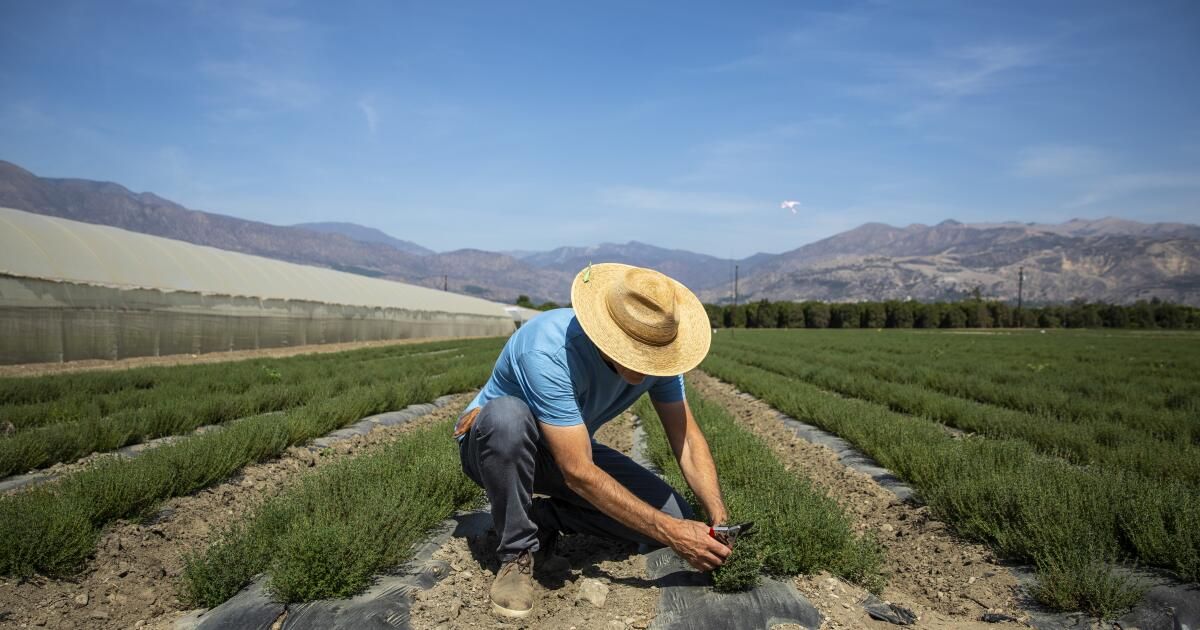To help California fight climate change, air quality regulators would like to see 20% of the state's farmland go organic by 2045. That means converting about 65,000 acres of conventional fields to organic practices every year.
But depending on how that transition occurs, the change could lead to a increase in the amount of pesticides used by producers across the state.
This is suggested by a new study in the journal Science that examined how organic farms influence the behavior of their neighbors. The researchers found that when new organic fields come online, the insects that accompany them can prompt conventional growers to increase their use of pesticides by an amount large enough to offset the reduction in organic fields, and then some.
“We expect an increase in organic in the future,” said study leader Ashley Larsen, a professor of agricultural and landscape ecology at UC Santa Barbara. “How do we make sure this doesn't cause unwanted harm?”
Organic farming practices help combat climate change by producing healthier soils that can retain more carbon and by avoiding synthetic nitrogen fertilizers, which fuel greenhouse gas emissions. Organic methods are also more sustainable for a warming world because they help the soil retain more water, among other benefits.
For their study, Larsen and his colleagues delved into agricultural practices in California's Kern County, where farmers regularly produce more than $7 billion worth of grapes, citrus, almonds, pistachios and other crops. Thanks to the county and state, there are detailed records going back years of how they do it.
Researchers examined about 14,000 individual fields between 2013 and 2019. They were able to see the shapes and locations of these fields, as well as whether they were growing conventional or organic crops and how much pesticide was used.
In fact, a key difference between conventional and organic farming is their approach to combating unwanted pests. Traditional farms may use toxic chemicals such as organophosphates and organochlorines, while organic farms prefer to keep harmful insects at bay by encouraging the growth of their natural enemies, including beetles, spiders and birds in particular. They may also use certain pesticides, which are typically made with natural rather than synthetic ingredients.
These contrasting strategies create complicated neighbors. If destructive bugs migrate from an organic farm to a conventional one, a farmer may respond by using more pesticides. That, in turn, would undermine the useful creatures that organic producers depend on. On the other hand, organic farms raise beneficial insects that migrate to other fields.
“Organic farms can be both a blessing and a curse if they are your neighbors,” said David Haviland, an entomologist with the integrated pest management program at the University of California, Bakersfield, who was not involved in the study.
In 2019, about 7.5% of permitted fields in Kern County were used to grow organic produce. They were distributed throughout the farming areas of the county, although many were grouped together in groups.
An aerial view of farmland and orchards near Maricopa at the southern end of the San Joaquin Valley in Kern County.
(Al Seib / Los Angeles Times)
With their data in hand, the researchers created a statistical model to see if they could find a relationship between pesticide use in a given field and the presence of nearby organic fields.
In the case of organic fields, they found that a 10% increase in neighboring organic farmland was associated with a 3% decrease in pesticide use. For conventional fields, the same 10% increase in organic neighbors came with a 0.3% increase in pesticide use.
Since conventional fields outnumbered organic ones by a wide margin, the net effect in Kern County was a 0.2% increase in pesticide use. Most of this was due to added insecticides rather than chemicals targeting invasive weeds or harmful fungi, Larsen said.
“We think it basically comes down to a different reliance on natural pest control methods,” he said. More insects are bad for conventional farmers because for them it means more unwanted insects, she explained. But more insects are good for organic farmers because it means having more natural enemies of those same pests.
The researchers also used their model to simulate different possible agricultural futures to see if this overall increase in pesticide use could be avoided. They discovered that the answer was yes.
One way was to expand the amount of land farmed organically. In their model, going from no organic fields to 5% organic cropland was associated with a 9% increase in insecticide use in Kern County. However, if 20% of farmland were grown organically (as anticipated by the California Air Resources Board), total insecticide use fell by 17%.
Those figures were based on a simulation in which organic fields were expanded, maximizing border skirmishes over pest control between organic and conventional fields. In a scenario where organic fields were clustered, increasing their combined footprint from 0% to 5% of the total area was associated with a 10% reduction in insecticide use, rising to 20% of the total area was linked to a 10% reduction in insecticide use. A 36% drop in chemicals, the researchers reported.
“What we basically see in the simulation is that while there could be an increase in the use of insecticides with low levels of organic matter, this can be completely mitigated by spatially clustering organic farmland,” Larsen said.
Making that happen in a simulation is one thing; doing it in the real world is another. An organic almond farmer whose orchard abuts a conventional one cannot easily dig up his mature trees and replant them elsewhere. But as farmers switch more conventional fields to organic, the results of this study could help them decide where to focus their efforts to reap the greatest benefits, Larsen said.
Likewise, policymakers could identify certain areas where they would like to see organic crops and offer incentives to encourage producers to take the leap. In principle, it would be similar to grants offered by the California Department of Food and Agriculture's Healthy Soils Program, he said.
Erik Lichtenberg, an agricultural economist at the University of Maryland, said the study makes “a compelling argument” that organic farms affect their neighbors, but it would be important to know many more details before concluding that it is a good idea to segregate organic farms. and conventional farms.
Among other things, “I would like to know more about why the fields are located the way they are, what is planted where, and how that relates to the pest management strategies that growers follow,” said Lichtenberg, who wrote a comment. that accompanies the study.
Haviland said the idea of clustering organic farms makes sense overall because it reduces the boundaries between organic and conventional fields. However, he noted that there are cases where grouping could make things worse.
Consider the glassy-winged sniper, who spreads a disease that kills vines. Conventional farmers have tools at their disposal to control them, but organic producers do not. When organic vines are more isolated, the chances of an insect wandering away from the field and “not coming home” are greater because it will find a pesticide nearby, Haviland said. But if all organic fields were lumped together, they would be “drastically adding to their own problem by not benefiting from the conventional producers around them.”
Haviland also emphasized that “there is a misconception among the general public that all pesticides are the same and all are bad, and that is definitely not true.” Reducing overall pesticide use is valuable, but it's more important to consider the types of pesticides used, she said.
Statistical analysis alone does not prove that the addition of organic fields is responsible for the change in pesticide use, but Larsen said the circumstantial evidence of a causal relationship is compelling. Conventional fields that acquired an organic neighbor tended to have the same pattern of pesticide use as their other conventional fields, and began to diverge only after the nearby field went organic.
“In our opinion, this is pretty strong evidence,” he said.
Milt McGiffen, cooperative extension specialist with UC Riverside's Department of Botany and Plant Sciences, wasn't so sure. He said growers strive to plant organic crops in places where they know pest control won't be a big problem since they can't use conventional pesticides.
“The main reason you have a group of organic farms together is because that's where there are fewer pests, not the other way around,” said McGiffen, who was not involved in the study.
He said there are many examples of governments trying to accelerate the transition to organic food production, but he is not aware of any efforts to encourage producers to locate organic fields in specific locations.
“This study has interesting ideas,” McGiffen said, but “some experimenter needs to go out and test all of this.”












